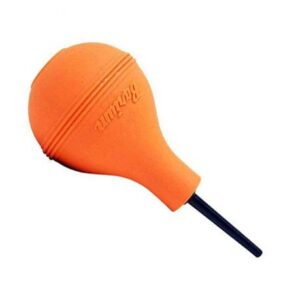An enema syringe is a device that is used to inject fluid into the rectum and colon for the purpose of cleansing, relieving constipation, or preparing for medical procedures. In this blog post, we will explain what an enema syringe is, how it works, and what are the benefits and risks of using it. We will also provide a brief overview of the types of enema syringes available, and compare and contrast their advantages and disadvantages. Finally, we will give you some tips and instructions on how to use an enema syringe safely and effectively.
What is an Enema Syringe and How Does It Work?
An enema syringe is a device that consists of a container that holds the fluid, a nozzle that is inserted into the anus, and a mechanism that controls the flow of the fluid. The fluid can be water, saline, oil, or herbal solutions, depending on the purpose and preference of the user. The fluid is injected into the rectum and colon, where it loosens and flushes out the fecal matter and toxins. The fluid is then expelled through the anus, along with the waste material.
What are the Benefits and Risks of Using an Enema Syringe?
Using an enema syringe can have several benefits, such as:
Cleansing the colon and improving the digestive health
Relieving constipation and promoting regular bowel movements
Preparing the colon for medical procedures, such as colonoscopy or surgery
Enhancing the absorption of nutrients and hydration
Boosting the immune system and preventing infections
Improving the mood and mental clarity
However, using an enema syringe also has some risks, such as:
Causing dehydration and electrolyte imbalance
Damaging the rectal or colon tissue and causing bleeding or perforation
Introducing bacteria or contaminants into the colon and causing infection or inflammation
Interfering with the natural flora and function of the colon
Creating dependency and reducing the natural peristalsis of the colon
Therefore, it is important to use an enema syringe with caution and moderation, and consult your doctor before using it if you have any medical conditions or allergies.
What are the Types of Enema Syringes Available?
There are different types of enema syringes available, each with its own features and drawbacks. Here are some of the most common types:
Bulb syringe: This is a small, rubber or plastic bulb with a nozzle that can hold up to 250 ml of fluid. It is easy to use, portable, and inexpensive. However, it has a limited capacity, which means you may need to refill it several times to achieve the desired result. It is also hard to clean, and may cause air bubbles that can cause discomfort or cramping.
Bag syringe: This is a larger, plastic bag with a tube and a clamp that can hold up to 2 liters of fluid. It allows you to adjust the flow of the fluid, and can be reused after proper cleaning. However, it is more expensive, harder to set up, and may cause leakage if not secured properly. It also requires a hook or a stand to hang it above the level of your abdomen.
Disposable syringe: This is a pre-filled, single-use plastic bottle with a nozzle that can hold up to 135 ml of fluid. It is convenient, sterile, and ready to use. However, it is more wasteful, less flexible, and may cause irritation if the fluid contains chemicals or additives.
How to Use an Enema Syringe Safely and Effectively?
If you decide to use an enema syringe, here are some tips and instructions on how to do it safely and effectively:
Choose the right type and amount of fluid for your purpose and preference. You can use plain water, saline, oil, or herbal solutions, depending on what you want to achieve and what suits your body. Generally, water and saline are the safest and most gentle options, while oil and herbal solutions can have stronger effects and may cause allergic reactions.
You can also add some ingredients to enhance the benefits of the enema, such as lemon juice, apple cider vinegar, baking soda, or coffee. However, make sure to use them in moderation and dilute them properly. The amount of fluid you need may vary depending on the type of enema syringe you use and the result you want. Usually, 250 to 500 ml is enough for a bulb syringe, 1 to 2 liters for a bag syringe, and 135 ml for a disposable syringe.
Consult your doctor before using an enema syringe if you have any medical conditions or allergies. Some conditions that may make using an enema syringe unsafe or ineffective are: pregnancy, hemorrhoids, anal fissures, diverticulitis, ulcerative colitis, Crohn’s disease, bowel obstruction, heart disease, kidney disease, or diabetes. Some medications that may interact with the enema fluid are: blood thinners, diuretics, steroids, or antibiotics. If you have any of these conditions or medications, you should avoid using an enema syringe or seek your doctor’s advice first.
Prepare the enema syringe and the area where you will perform the enema. Make sure the enema syringe is clean and sterilized, and the fluid is at a comfortable temperature, not too hot or too cold. You can test the temperature by putting a drop of the fluid on your wrist. You should also prepare the area where you will do the enema, such as a bathroom or a bed with towels. You will need some privacy, a comfortable position, and a place to expel the fluid afterwards. You can also play some relaxing music or light some candles to create a soothing atmosphere.
Lubricate the nozzle and insert it gently into your anus, about 3 to 4 inches deep. You can use some natural lubricant, such as coconut oil or olive oil, to make the insertion easier and smoother. You should also relax your muscles and breathe deeply to reduce any tension or pain. You can choose any position that feels comfortable for you, such as lying on your back, on your side, or on your knees. However, some positions may facilitate the flow of the fluid better than others, such as raising your hips or massaging your abdomen.
Squeeze or release the fluid slowly and steadily into your rectum and colon, until you feel full or the syringe is empty. You should not rush or force the fluid, as this may cause cramping, bloating, or leakage. You should also listen to your body and stop if you feel any discomfort or pain. You can try to hold the fluid for as long as you can, or as directed by your doctor, to allow it to reach and cleanse the entire colon. However, you should not hold it for more than 15 minutes, as this may cause dehydration or electrolyte imbalance.
Hold the fluid for as long as you can, or as directed by your doctor, then expel it into a toilet or a bucket. You should release the fluid when you feel the urge to do so, or when you can no longer hold it. You should not strain or push, but let the fluid come out naturally. You may also notice some fecal matter or mucus coming out with the fluid, which is normal and indicates that the enema is working. You should expel the fluid into a toilet or a bucket, and flush or dispose of it properly.
Repeat the process if necessary, until the fluid comes out clear or you achieve the desired result. You may need to repeat the enema several times, depending on the type of enema syringe you use and the result you want. For example, if you use a bulb syringe, you may need to refill it and do the enema 3 to 4 times. If you use a bag syringe, you may need to do the enema once or twice. If you use a disposable syringe, you may need to use 2 to 3 bottles. You should stop the enema when the fluid comes out clear, or when you feel clean and refreshed.
Clean and store the enema syringe properly after use, or dispose of it if it is single-use. You should rinse the enema syringe with warm water and soap, and dry it thoroughly. You should also sterilize it with boiling water or alcohol, and store it in a clean and dry place. If the enema syringe is single-use, you should discard it after use, and not reuse it.
Conclusion
Using an enema syringe can be a beneficial and effective way to cleanse your colon and improve your health. However, you should also be aware of the risks and precautions of using it, and consult your doctor before doing so.
You should also choose the right type of enema syringe for your purpose and preference, and follow the tips and instructions on how to use it safely and effectively. We hope this blog post has given you some useful information and guidance on how to use an enema syringe.

